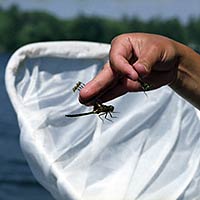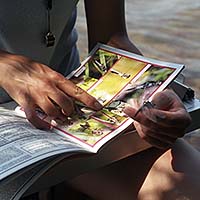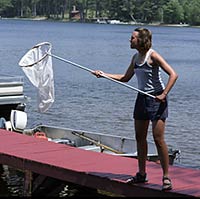Dances with Dragonflies: Agile Insect a Signal of Shoreline Health
Agile Insect a Signal of Shoreline Health
It looks incredibly easy until you actually try to catch one.
The dragonfly seemingly floats in hypnotic slow motion—until of course, it zaps right out of your net.
Doctoral student and expert dragonfly catcher, Alysa Remsburg, says the trick is to “swipe-and-flick:” the moment you swipe a dragonfly, flick your wrist to trap it!

Doctoral student Alysa Remsburg displays two of the dragonflies she caught with her net.
Remsburg is the first UW-Madison student at Trout Lake Station to study dragonfly and damselfly communities. Wisconsin’s North Woods are home to roughly 70 dragonfly species, but she is one of very few odonatologists—the tongue-twisting name for dragonfly experts—in the entire state of Wisconsin.
Most people don’t know a whole lot about the beguiling insects because they spend most of their lives as larvae underwater. When dragonflies finally do emerge in adult form, they fly around for only a month before perishing. Dragonflies rest with their wings apart, while their slender, graceful cousins, the damselflies, sit with their wings together.
Still, “dragonflies are such an obvious feature of the shoreline,” says Remsburg, during a warm afternoon drive to Black Oak Lake, one of 17 lakes where she has selected sites for study. “They like to live at the edge of two ecosystems, which potentially makes them good indicators for other species that also need transition environments.”

Remsburg consults a field guide to identify a dragonfly she caught along the shore of Black Oak Lake.
Hoping to discern the ecological impact of lakeshore development on dragonfly diversity, Remsburg plans to compare numbers of dragonfly species in manicured, developed sites, with numbers in untouched, forested locations. “There is some indication that numbers of dragonfly species decline where there are lawns, no shrubs and no tall grasses,” Remsburg says, speaking of preliminary data she gathered last summer. “People may not notice mayflies and snails, but dragonflies are beautiful so they could serve as a tool for people to pay attention to natural species.”
The young researcher hopes that her data will confirm that enforcing a shrub layer of a certain height could do a lot to preserve native species along lakeshores. A local statute also requires that shoreline properties refrain from carving lawns right up to the lake’s edge, and leaving at least 30 feet of “buffer” shoreline. “I hope my data will support the need for a buffer requirement,” says Remsburg, “because right now it’s totally not enforced.”
Today, Remsburg visits a shorefront property along Black Oak Lake, a deep body of water whose borders have been lined with old logging homes for several generations. This private property is manicured right to the lake’s edge, replete with flowerbeds, picnic chairs, a bonfire pit and a long dock extending into the water.

Amidst all the trappings of lakeshore development, Remsburg scans the sky for dragonflies.
“This can be a hilarious sight,” Remsburg remarks as she squints into the sky and swoops her net around. Within minutes, she catches at least three different types of dragonfly including a Spiny Baskettail and a gleaming American Emerald, which exactly resembles its name.
To roughly determine how many dragonflies are around, Remsburg walks along the lake for three minutes, yelling the taxonomy of every dragonfly she sees to her undergraduate assistant Bridget Henning. "EP! EP! EP!" she screams, referring to a particularly common dragonfly of the Epitheca family. To ordinary ears, Remsburg’s shouts are incomprehensible, but the scene is incredibly entertaining all the same.